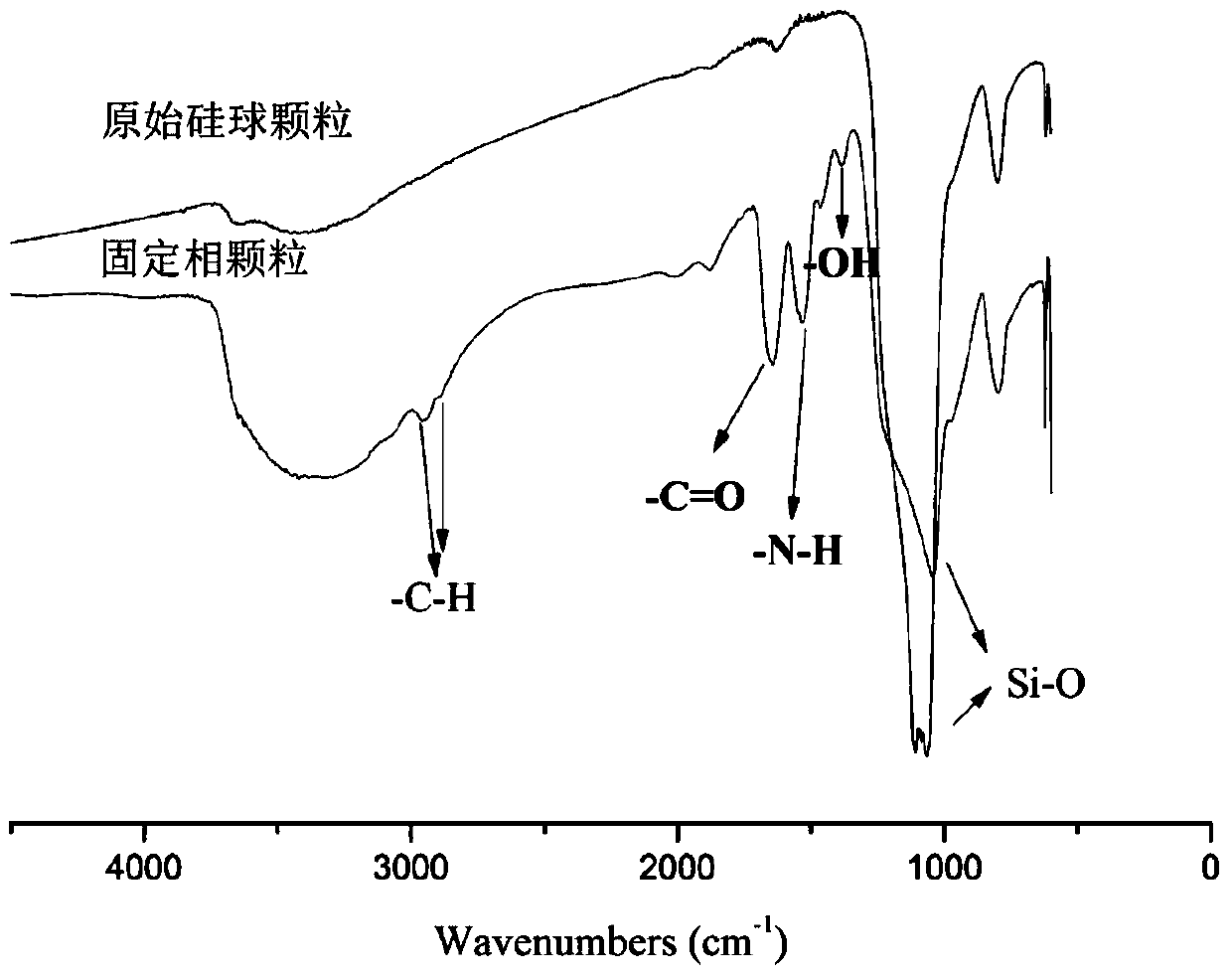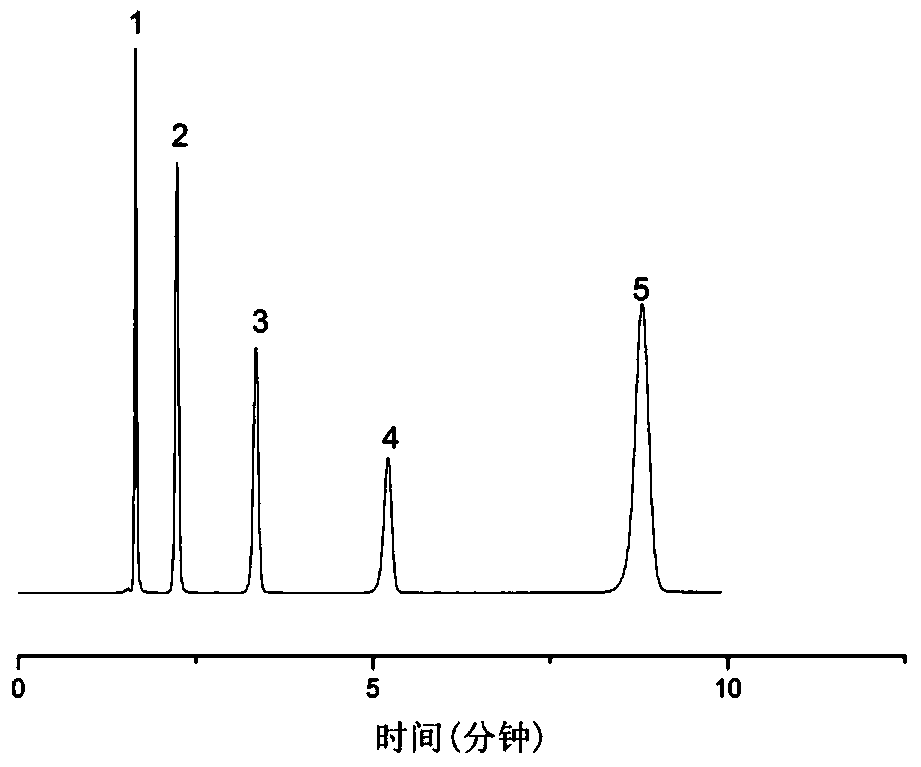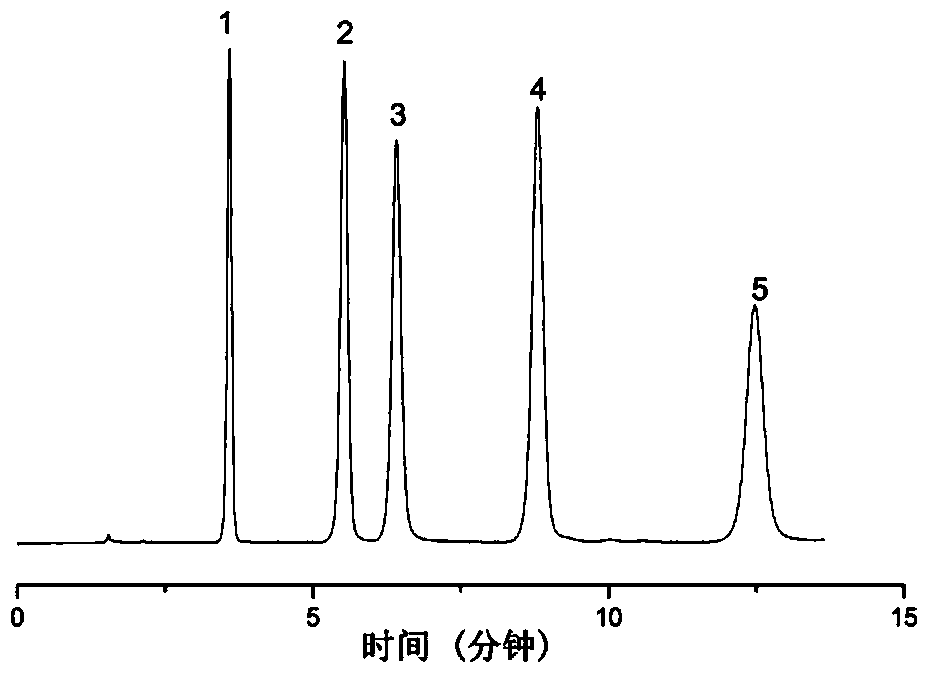Polymer Chain Modified Silica Matrix Hydrophilic Interaction Chromatography Stationary Phase and Its Preparation and Application
A chromatographic stationary phase and hydrophilic interaction technology, which is applied in the field of hydrophilic interaction liquid chromatography stationary phase and its preparation, can solve the problems of complex preparation, insufficient separation selectivity, and insufficient hydrophilicity of the stationary phase, and achieve high reaction efficiency and application Wide range and good dispersion effect
- Summary
- Abstract
- Description
- Claims
- Application Information
AI Technical Summary
Problems solved by technology
Method used
Image
Examples
Embodiment 1
[0040] 1. Preparation of mercaptosilica spheres: In a 250mL round bottom flask, add 120mL of toluene, add 5g of silica gel particles with a particle size of 5μm, and 2ml of 3-mercaptopropyltriethoxysilane, and disperse evenly by ultrasonication for 2 minutes. Connect a condenser tube to the flask, stir mechanically, maintain a speed of 300 rad / min, and pass nitrogen gas for 10 minutes. The reaction device was placed in an oil bath, heated to reflux at 110°C for 13 hours, the reaction was stopped, and cooled to room temperature. Centrifuge at a speed of 3000 rad / min in a high-speed centrifuge, remove the supernatant, use toluene, acetone, methanol, and acetone to filter and wash in sequence, repeat the suction and filter for 3 times, and dry in a vacuum oven at 50°C for 24 hours to obtain Silica gel particles modified with mercapto groups.
[0041]2. Preparation of hydrophilic polymer chains on the surface of silica gel: In a 250mL round bottom flask, add 100mL of the reaction...
Embodiment 2
[0045] The stationary phase particles prepared in Example 1 were filled in a 4.6mm*150mm stainless steel HPLC column, and the prepared chromatographic column was used to separate the mixture of nucleosides and bases in a hydrophilic mode. The separation conditions are: acetonitrile / water (volume ratio is 81 to 19) as mobile phase, flow rate is 1ml / min, column temperature is 25°C, the separation chromatogram is as follows figure 2 As shown, 1, 2, 3, 4, and 5 in the figure are respectively thymidine, uridine, cytidine, cytosine, and guanosine. The separation results show that on the hydrophilic interaction chromatographic column provided by the invention, nucleosides and bases are well separated by baseline, indicating that the stationary phase has typical hydrophilic interaction characteristics and good separation selectivity.
Embodiment 3
[0047] Organic acidic compounds were separated using the hydrophilic interaction chromatographic column prepared in Example 2. The separation conditions are as follows: 88% acetonitrile, 2% ammonium acetate (100 mM concentration), and 10% water are used as the mobile phase, the flow rate is 1 ml / min, and the column temperature is 25° C. The separation chromatogram is as image 3 As shown, 1, 2, 3, 4, and 5 in the figure are respectively phenol, p-cresol, 3,5-dinitrobenzoic acid, benzoic acid, and 4-hydroxybenzoic acid. The separation chromatogram shows that these several organic acids have good retention on the chromatographic column provided by the invention, and good baseline separation is obtained.
PUM
| Property | Measurement | Unit |
|---|---|---|
| particle diameter | aaaaa | aaaaa |
| thickness | aaaaa | aaaaa |
| pore size | aaaaa | aaaaa |
Abstract
Description
Claims
Application Information
 Login to View More
Login to View More - R&D
- Intellectual Property
- Life Sciences
- Materials
- Tech Scout
- Unparalleled Data Quality
- Higher Quality Content
- 60% Fewer Hallucinations
Browse by: Latest US Patents, China's latest patents, Technical Efficacy Thesaurus, Application Domain, Technology Topic, Popular Technical Reports.
© 2025 PatSnap. All rights reserved.Legal|Privacy policy|Modern Slavery Act Transparency Statement|Sitemap|About US| Contact US: help@patsnap.com



